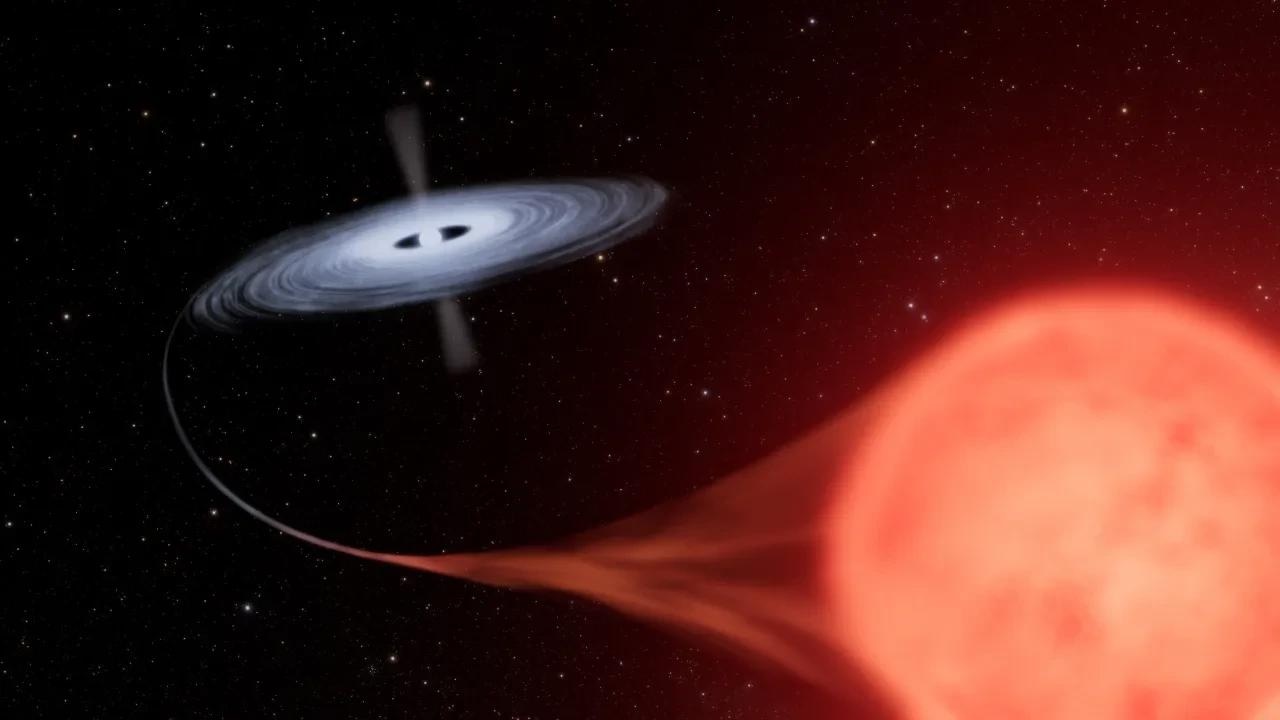Reviewed by Lexie CornerJun 11 2024
Researchers from the Space Telescope Science Institute (STScI) have taken a new look at one of the most enigmatic binary star systems in the Milky Way. The study, published in the Astrophysical Journal, utilizes data from NASA's Hubble Space Telescope, the defunct Stratospheric Observatory for Infrared Astronomy (SOFIA) mission, and historical observations, offering fresh insights into this peculiar system.
 This artist’s concept shows the nova system HM Sagittae (HM Sge), where a white dwarf star is pulling material from its red giant companion. This forms a blazing hot disk around the dwarf, which can unpredictably undergo a spontaneous thermonuclear explosion as the infall of hydrogen from the red giant grows denser and reaches a tipping point. These fireworks between companion stars are fascinating to astronomers by yielding insights into the physics and dynamics of stellar evolution in binary systems. Image Credit: NASA, ESA, Leah Hustak (STScI)
This artist’s concept shows the nova system HM Sagittae (HM Sge), where a white dwarf star is pulling material from its red giant companion. This forms a blazing hot disk around the dwarf, which can unpredictably undergo a spontaneous thermonuclear explosion as the infall of hydrogen from the red giant grows denser and reaches a tipping point. These fireworks between companion stars are fascinating to astronomers by yielding insights into the physics and dynamics of stellar evolution in binary systems. Image Credit: NASA, ESA, Leah Hustak (STScI)
A nova is a star that suddenly brightens and then gradually returns to its previous level of obscurity, usually within a few months or years.
The binary system HM Sagittae (HM Sge) became 250 times brighter between April and September 1975. What is even more unusual is that, unlike most novae, it did not fade away quickly; instead, it remained bright for decades. Recent observations indicate that the system has paradoxically faded a little while getting hotter.
HM Sge is a unique symbiotic star system where a white dwarf and a bloated, dust-producing giant star orbit each other eccentrically. In this system, the white dwarf consumes gas that flows from the giant star. That gas forms a blazing hot disk around the white dwarf, which can undergo a spontaneous thermonuclear explosion as the infall of hydrogen from the giant grows denser on the surface until it reaches a tipping point. Astronomers are fascinated by these fireworks between companion stars because they provide information about the dynamics and physics of stellar evolution in binary systems.
In 1975, HM Sge went from being a nondescript star to something all astronomers in the field were looking at, and at some point, that flurry of activity slowed down.
Ravi Sankrit, Space Telescope Science Institute (STScI), Baltimore
Using instruments on Hubble and SOFIA, Steven Goldman of STScI, Sankrit, and collaborators examined changes to HM Sge over the previous 30 years at light wavelengths ranging from infrared to ultraviolet (UV) in 2021.
A strong emission line of highly ionized magnesium was visible in the Hubble ultraviolet data from 2021, which was not visible in the previously published 1990 spectra. Its existence indicates that the white dwarf and accretion disk's estimated temperature has risen from less than 400,000 ºF in 1989 to more than 450,000 ºF at present. The UV spectrum contains numerous lines, including the highly ionized magnesium line. When these lines are examined collectively, the energetics of the system and its evolution over the previous thirty years can be deduced.
When I first saw the new data, I thought, ' Wow, this is what Hubble UV spectroscopy can do!' I mean, it's spectacular, really spectacular.
Ravi Sankrit, Space Telescope Science Institute (STScI), Baltimore
Utilizing information from NASA's flying telescope SOFIA, which was decommissioned in 2022, the group identified the movement of gas, dust, and water within and around the system. According to infrared spectral data, the giant star, which creates a lot of dust, returned to normal behavior within a few years of the explosion. However, it has dimmed recently, another mystery that needs to be solved.
Astronomers believe the water's velocity of about eighteen miles per second, which they observed with SOFIA, is the speed of the white dwarf's smoldering accretion disk. The gas bridge that joins the giant star and the white dwarf must be around two billion miles long.
Additionally, the team has been collaborating with amateur astronomers worldwide through the AAVSO (American Association of Variable Star Observers) to keep telescopic eyes on HM Sge. Their ongoing monitoring reveals changes to the star that haven't been seen since its outburst 40 years ago.
Symbiotic stars like HM Sge are rare in our galaxy, and witnessing a nova-like explosion is even rarer. This unique event is a treasure for astrophysicists spanning decades.
Steven R. Goldman, Space Telescope Science Institute
Sankrit is presenting research on UV spectroscopy at the 244th meeting of the American Astronomical Society in Madison, Wisconsin.
Journal Reference:
Goldman, R. S., et al. (2024) A Multiwavelength Study of the Symbiotic Mira HM Sge with SOFIA and HST. The Astrophysical Journal. doi.org/10.3847/1538-4357/ad12c9